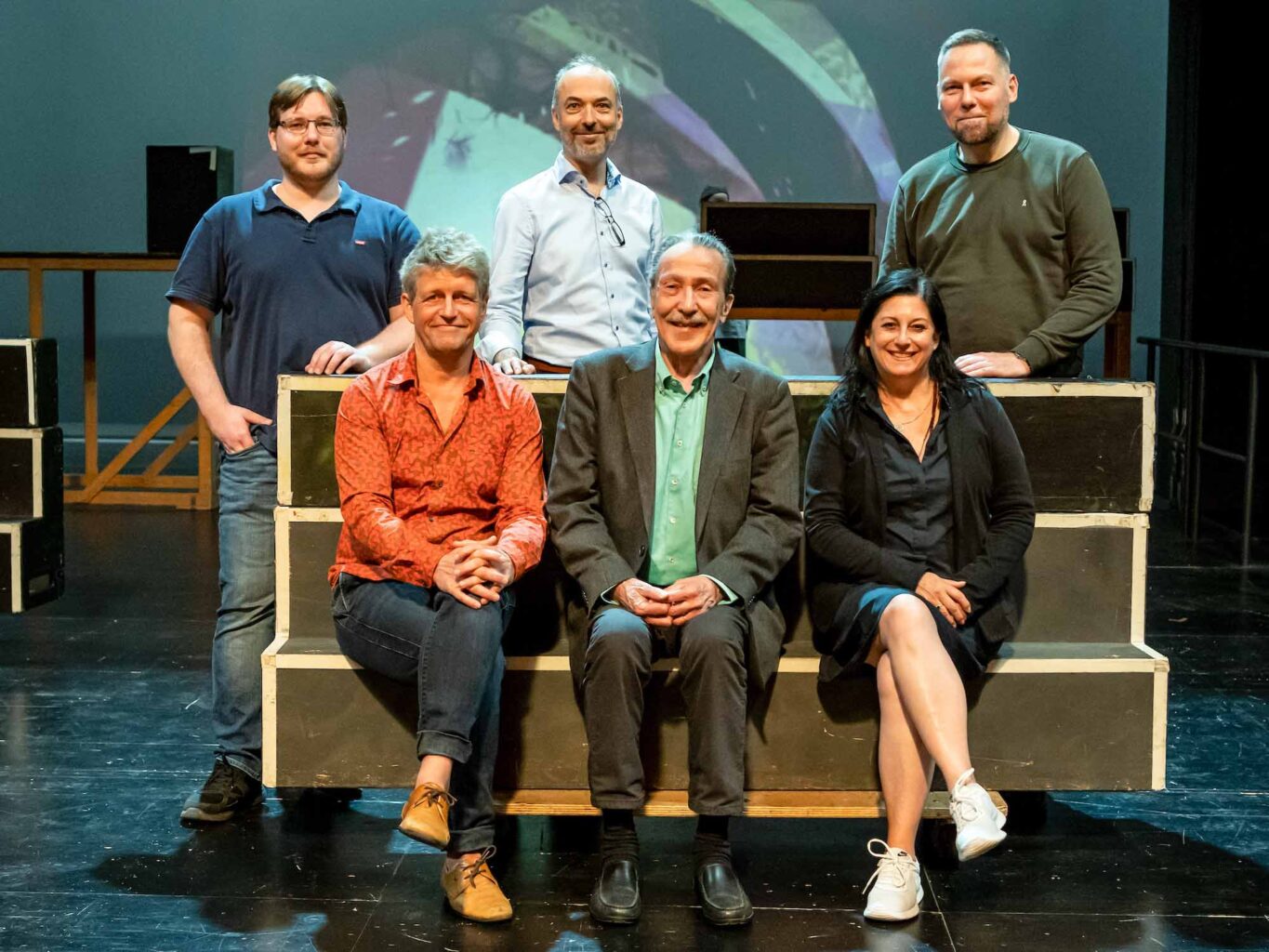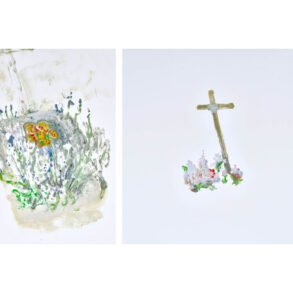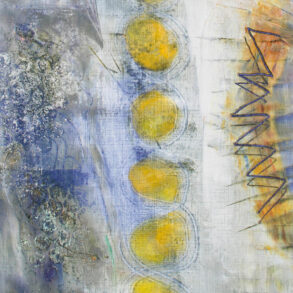An interview about the ‹Parsifal› production at the Goetheanum at Easter, 2023, with Jasmin Solfaghari, the Lead Director, and Stefan Hasler, Director of Eurythmy. Wolfgang Held asked the questions.
How did you get into theatre and opera?
Jasmin Solfaghari: Apart from my aunt, who was a ballet dancer in Freiburg, and a distant uncle who was a well-known violinist, there were no professional artists in the family. A dress-up box in the attic of my parents’ house reminded me of my aunt’s childhood roles. When I took the costumes out, the smell of the theatre surrounded me. I also had an uncle who was infatuated with opera. Professionally, he floundered, but the opera gave him a home. He lived in the same house as my family, drew, made stage sets, and listened to a wide range of classical music. I later played the flute in an orchestra in Freiburg. After graduating from school in music, I first studied musicology, art history, and German language and literature at the University of Freiburg. But I always had my eyes on the theatre. That’s why I then moved to Hamburg to study opera directing after an internship at the Freiburg City Theatre.
From reflection on theatre, we moved into practice. Into the practice of opera?
Solfaghari: Yes, and yet I have remained faithful to both. What fascinated me about opera was the vibrancy of this art. Every second something original takes place, consisting of numerous art forms. It is, I think, this very specific moment that is purely ‹now›. This is what excites me so much about opera.
Stefan, how did your window to the opera open?
Stefan Hasler: In my youth! I later studied piano in London and always carried opera within me, because this art form brings together all art forms, from acting, to stage design to a symbiosis of musical, vocal, and orchestral colour. When I travel, I always look to see what’s playing in the evening at the opera house in the city where I happen to be, and that’s where you’ll find me.
And now you are staging ‹Parsifal› at the Goetheanum.
Hasler: I am very grateful for the opportunity we now have and am extraordinarily excited to see what comes of it when we bring this tremendous work by Wagner to the stage here at the Goetheanum. My passion for opera is not much less than that for Eurythmy.
There is some improvisation in theatre. Opera cannot offer that and at the same time, there is a greater happening in opera than in a symphony concert. Does opera have both – theatre and the symphonic?
Hasler: In opera, you tell a story instrumentally as well as vocally. This brings such a wealth of happening to the stage that has to be worked on again and again. It brings the instrumentalists into the flow, brings them into the happening that then leads to this musical event of the opera. These are the primal elements of music. I sing, play, dance, and make music.
Solfaghari: There is also improvisation in opera performances. Sometimes more than we would like because often individual singers have to stand in. And then an assistant or I stand at the side of the stage like traffic officers to support them stage-wise. It’s almost like in Rossini’s time when they improvised cadenzas and sang the aria differently on a Wednesday from a Friday.
Hasler: In every performance, you are in the process of forming the dynamics and flow of the images differently, anew. You can do this if you know the score inside out.
How did you first encounter Wagner?
Solfaghari: This happened through my uncle who was in the Freiburg Wagner Association. I was also an extra in ‹Rheingold› at the municipal theatre there. Studying directing with Götz Friedrich, the focus in the early 1980s was on his conception of Wagner’s ‹Ring of the Nibelung› at the Deutsche Oper Berlin. I then co-directed this work in revivals much later as chief director. As an assistant, I was able to get to know and help realise the fabulous Berghaus production of ‹Tristan und Isolde› and Günther Krämer’s production of the ‹Ring› at the Hamburg State Opera. At the Cologne Opera, I had the opportunity to direct ‹Tannhäuser›, and in Odense in 2018 – as a stand-in – I got my own ‹Ring›.
Hasler: The richness of Wagner, this soul landscape in the music, is unique. I think anyone who loves orchestral colours is bound to end up with Wagner at some point. That is my starting point, rather than the content. At the same time, ‹Parsifal› is in turn unique within Wagner’s oeuvre because here the stage becomes a sacred festival and he wrestled with this work all his life. He was concerned with making profound questions of life visible and audible. This is something that has preoccupied me since I first experienced opera at the age of seventeen.

And now you are staging ‹Parsifal› at the Goetheanum on Easter, 2023.
Solfaghari: The idea came from Alexander von Glenck, who is sponsoring this project with our production company Pamy and our partner, the Goetheanum.
Hasler: I am very grateful that Alexander von Glenck is involved with all his love and passion as a musician, singer, Anthroposophist, producer, and initiator of ‹Parsifal›. He has been associated with the idea of staging ‹Parsifal› at the Goetheanum for 15 years. That gives this project its base! For Eurythmy, it is an incredible opportunity to go beyond the choreography of a single symphony, beyond ‹Faust› and the Mystery Dramas, where we have a long tradition of Eurythmy performance, to literally go full throttle here and ask ourselves: how do we manifest the spiritual power of the Grail for the audience?
What ideas did your collaboration provide you with?
Solfaghari: One idea arose, for example, when Stefan Hasler, Walter Schütze, and I were talking about props: Eurythmy makes it possible to do without props. I have also striven for something like this in terms of abstraction in earlier productions, but here it requires a completely different form and consistency. Now we must consider how a grail, a spear, or a swan appear not only non-figuratively but through a Eurythmy. In principle, there are three levels of representation. We have the Eurythmy, the performance level of the soloists, and that of the choir. Here it is the case that the choir is more a kind of Greek choir that reflects. It needs a stance that does not duplicate what can be seen on stage through Eurythmy. There is much to learn and create here.
Hasler: What is a general challenge for us is to do full justice to the opera and at the same time to keep in mind the original and specific nature of the Goetheanum as a performance venue. The stage designer Walter Schütze has devoted himself to this question in particular: what are the spatial relationships, how does the stage space speak and how can we let Wagner’s ‹Parsifal› unfold? Klaus Suppan is responsible for the lighting design. He is at home in Eurythmy and drama and is now conquering the terrain of opera. We will also have the choir sing from the gallery so that the audience is completely inside the whole sound structure. Real bells will also ring from there. Our aim is for the audience to be fully immersed in the happening. The Goetheanum offers magnificent possibilities for such a sacred festival drama, as Wagner called it. You come up the hill to the Goetheanum and detach yourself from your everyday life.
Solfaghari: I also think that for this production this particular place is very inspiring. With Walter Schütze, the starting point was, among other things, the aesthetics of the Swiss scenographer Adolph Appia with his spatial concepts that were completely new in Cosima Wagner’s time. This exploration, which has to be reconciled with the Eurythmy and operatic direction, will be the great challenge of this production. A symposium on stage design will also take place at the Goetheanum on the 25th/26th of March 2023.
Hasler: Klaus Suppan will give each of the opera’s three acts its own light envelope, so that, as in the stage design, an entire arc spans the six hours of performance.
How do you capture the mythical power of this work? This spiritual dimension plays a special role for a performance at the Goetheanum.
Hasler: Every character on stage follows a path. We strive for each individual in the audience to be able to identify with the characters in such a way that the power of love, the connection of the individual actors to each other, reaches the audience. Here it is not the historical image that counts, but what happens with the characters.
Solfaghari: I was fascinated by a sketch of the first performance of ‹Parsifal›. In it, the choir is depicted at the end as individuals. Each person stands by themselves! I found that interesting and it coincides with my approach. How the soul processes of the stage characters are perceived by the audience is a challenge. If I depict a great collective harmony on stage, then in directing an opera this does not necessarily mean that the audience will feel harmony, they may even feel put off. When I see a role struggling with themselves and I hear harmonious sounds at the same time, I feel that the character is on their way. And that can possibly touch me more as a viewer than someone who shows: «I’m in Nirvana, in Elysium and happy.» The task is to convincingly portray Kundry’s entangled path of suffering, dealing with guilt, the search for redemption, and, last but not least, the experience of empathy.
Translation Christian von Arnim









